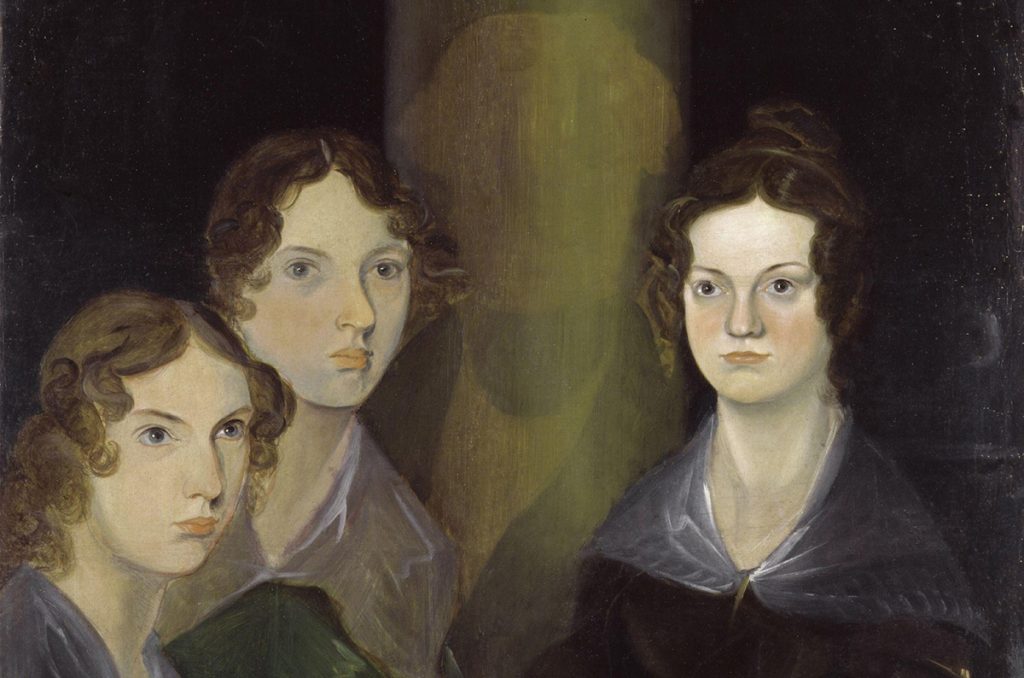Pentimento: On Norah Lange and “People in the Room”
Greg Walklin
*People in the Room and Other Stories, by Norah Lange. Translated by Charlotte Whittle
Among the many paintings in London’s National Portrait Gallery is a portrait of the Brontë Sisters. They are all portrayed with stern expressions, similarly styled hair, and pale complexions. The style is not original, and the canvas has several deep creases, as a result of being folded on top of a cupboard. What perhaps makes the picture unique, however, is that the artist, Patrick Branwell Brontë, the brother of Anne, Emily, and Charlotte, originally painted himself in the portrait, but then removed himself before finishing. One can still see his faint outline in the gap between Emily and Charlotte, turned forever into a pillar.
Upon seeing a reproduction of Branwell Brontë’s banal family portrait, Norah Lange was inspired. An Argentine, she was in her forties, with several published books—she had already been writing and publishing successfully for two decades. Lange had received acclaim for the memoir Notes from Childhood (Cuadernos de infancia) and the provocatively titled 45 Days and 30 Sailors (45 días y 30 marineros). Having hit a new era in her career, she had disowned much of her poetry, written when she was a young woman. Lange had always been acutely aware of the limitations placed on female writers in the middle of the 20th century. Not much, it seemed, had changed in the century since the Brontës, at least in terms of what was acceptable for women to write about —venturing beyond the domestic, in other words, was stepping into enemy territory. Married to a male writer with another famous male writer for a friend, Lange witnessed how the scales were tipped in their direction. Seeing the portrait of the Brontë Sisters actualized her instincts. So, she set out to write about three sisters herself, drawing on all of this repression and claustrophobia and patriarchal limitation.

© London’s National Portrait Gallery
This ultimately became the novel People in the Room (Personas en la sala). Originally published in Spanish in 1950, People in the Room has finally been brought to English by And Other Stories in a translation by Charlotte Little. Even in Spanish, a number of Lange’s works are still out of print in Argentina, and if one conducts an Amazon search for other English translations of Lange, for example, one is likely to end with an empty shopping cart. Thanks to Little’s translation, a simple search engine query will at least turn up much in English about Lange’s biography: how she was “Borges’s Muse” and how she was the doyen of the avant-garde literary scene in mid-century Argentina. One can read all about her marriage to Olivero Girondo, for example, or her friendship with García Lorca, or her literati dinner parties, or her Norwegian parentage, or her connection with the Ultraist poetic movement and the magazine Martin Fierro. The trouble begins if one wants to dig into the books themselves.
Lange, it seems, has become a victim of pentimento, her avant-grade writing scrubbed out in favor of Borges and his expansive scope. (Even Borges, when complementing her, couldn’t resist talking about her hair at the same time.) To be fair, Lange does probably appear in this metaphorical portrait, albeit as a hostess and side character at the edge of the frame in the greater Borgesian triptych. In his introduction to this edition, César Aira notes that the “traditionally feminine subject matter” Lange wrote about was relegated to irrelevance, or treated with the literary equivalent of a pat on the back and a patronizing “That’s very nice, dear.”
Lange’s brilliance lies in the fact that she saw this coming a long time ago.
**
In People in the Room, the victim of pentimento is an unnamed 17-year-old girl living in Buenos Aires. Bookish and introverted, she becomes obsessed with the lives of three unmarried sisters who live across the street, and who don’t close their shutters “because,” one tells the narrator, “we’re of no interest to anyone.” When the narrator first notices them, they appear wraithlike, almost ghostly: “I settled in by the window and waited a few minutes,” she says. “After a while I saw three shadows, slender as poplars, strikingly lengthen by the streetlamp on the corner, and soon afterwards, they took the place of their shadows.” Although the narrator gets to know the sisters more as the novel progresses, they essentially remain shades—mysterious and evasive, like they both want to be known but prefer their anonymity. Similarly, the narrator wants to know everything about them; except, well, when she doesn’t, as she imagines asking them important questions, like why none of them married, or if they had always lived together, all the while her fantasy demanding leaving before they answer. Her ambivalence makes her wants to know as much as possible, as long as it doesn’t spoil the mystery.
At first Lange’s writing appears deliberately vague, sometimes not mentioning who is speaking or what about. At times this is frustratingly dense, as when she constructs scenes and intentionally leaves out key details. At one point, the narrator intercepts a telegram meant for the sisters, and muses about its message —yet the reader is left, in the end, to conjecture what it was really about, just like we’re left to wonder why one of the sisters habitually cries (to be fair, it’s easy to conjecture). The narrator imagines their pasts and the reasons why she sees one of them in tears, or why they adhere to such a strict routine (they sit in the same spots in the same chairs in the same room, day after day). Everyday banalities become, for the narrator, enticing dramas.
Overall, though, not much happens in People in the Room. The narrator gets to know the women a bit more, sees further glimpses of their secrets and lives, and becomes more estranged from her own family. Finding anything substantial about anyone seems to be far from the book’s purpose. Watching the sisters at night, the narrator falls asleep, only to wake back up and see the sisters sitting in the exact positions they were in before she dozed off. In what must be the only time such a sentence has been written for an official introduction to a book, César Aira writes, “People in the Room is not a novel to be read for pleasure.” While it’s true that the novel does not sail along, it is also evident—taking liberty with an ambiguity in Aira’s sentence—that one finds the characters themselves experiencing very little pleasure. The narrator’s obsession with the three sisters seems more masochistic than voyeuristic. She feels compelled to watch, or entrapped, in the same way that the sisters seem compelled to leave their shutters open.
Through this prism Lange examines several topics, including how the stultifying boredom of adolescence transforms into the limited banality of adult womanhood. Perhaps the topic of just how boring it must have been to be in such a situation has never been as detailed as in People in the Room; it’s no wonder everyday banalities become so interesting. The book takes the idea and hammers on it until the banalities become enigmas.
Perhaps the narrator is so compelled because she is glimpsing a future that she cannot avoid, or perhaps it is more like the reason one rubbernecks past a car accident. She admires the women, but also seems horrified by them, which forms a sort of sublime mix. Shirley Jackson’s stories (“We Have Always lived in the Castle”, for instance) come to mind, as well as some of Faulkner’s turns toward the gothic, especially another story about an isolated woman, “A Rose for Emily” (indeed, Faulkner was Lange’s favorite author).
The narrator ultimately obscures herself completely in her portrait of the three sisters. The story leaves us clueless as to so many details of her life that all we are ultimately left with is her as the watcher, her as the witness, her as the cypher through which we see the sisters. She is no more than a column in the wall, the painter whom we only know exists because, well, someone had to paint the painting.
***
One of the ways People in the Room can be read—and it can be read it so many ways—is as a commentary on women’s role in the 20th century. In the introduction to the English translation, Cesar Aira writes that in Lange’s work “traditionally feminine subject matter is excavated so deeply that something entirely different emerges.” While Borges was exploring infinite labyrinths of books, Lange was excavating a simple sala. Lange dealt with the restrictions imposed on women writers—pigeonholed in their fiction just as they were into a certain way of life—in a unique way. Instead of trying to shuck off the restraints, she decided the best way to attack was to destroy them from the inside. To mine so deeply all the shafts collapse.
Lange portrays the domestic sphere in all its claustrophobic, depressing ennui. It’s so bad that the narrator constantly thinks about the sisters dying, and contemplates their suicides. “Who will mourn for them?” she wonders. Toward the end of the novel, when she is off traveling, she at once wishes to see them dead to avoid having to miss them. Some of this, of course, is just teen dramatics —one imagines that in a different era the narrator would be in the middle of her goth phase:
No, I wasn’t waiting for them to die, but for a face, the least beloved, to emerge from their almost furtive coexistence, and for it to begin to contrive something possessed by other women, men, and abandoned houses; something that might easily be added to certain days and certain nights; something that might exist without a why; for them to be able to say, ‘Let’s sit at the table,’ without it implying yet another sorrow…
It is hard to get more foreboding than that. The narrator transforms into a Cassandra who sees her future across the street, and who not only realizes no one will listen to her, but that nobody cares. Spinsterhood is a fait accompli.
***
Another way to read People in the Room centers on the manifest obsession of the narrator. It’s a portrait of obsession and its pitfalls —which has led the narrator to forget that she exists, to forget her family, and fail to engage with the world around her. She lives only to see. “Perhaps I didn’t understand them,” she says of the sisters, “but I watched them.” (One is reminded of the Eye of Sauron, disembodied but all-seeing, shooting its gaze from atop a tower.) The narrator’s thoughts slowly atomize, and turn much more serious: Lange breaks down her theme into its constituent parts, and the result proves to be greater than the whole. The more focused the narrator becomes, the stranger the world she focuses on, and the more she breaks down each scene and characters the more palpable the feeling of estrangement. As one becomes obsessed, one ironically becomes more distanced from the object of obsession, more captured by one’s own interest than in the object itself.
There is an old thought experiment, one of the oldest in Western philosophy, posed by Plato and Heraclitus, involving the Ship of Theseus. Say, the hypothetical goes, there is a historic Ship of Theseus decommissioned and put on display. Over the years, some pieces of it rot and need to be replaced. Once enough time has passed, we are instructed to imagine, all of the original pieces of the ship have been replaced. Is it still the same ship? This is an apt way of approaching The People in the Room, which seems to continuously replace each bit of a typical domestic life, bit by bit, that at the end, we ask ourselves, are these even the same three sisters and narrator we started with? Is the narrator even the same person who started watching them? They seem to mix and match parts and sorrows until one cannot quite say where the watcher begins and the watched end. By the end of the book, the narrator, still nameless, hardly seems to be a character at all.
***
One would be unlikely to find as vivid picture of alienation in 20th century literature painted in People in the Room, outside Camus or Kafka. Yet Norah Lange is, unlike those other male writers, not well known. Charlotte Little’s translation does something to change that. Lange, as Aira admitted, is not easy reading, but neither were The Fall or The Castle. This English translation, apt and adept at conveying the spell the narrator seems to be under, should disabuse readers of the notion that only good works on the existential despair of the postwar world came from men. People in the Room rightfully deserves to be read alongside those European novels for the way it captures the same kinds of existential dread and purposeless, then rounds it out by showing it from the female perspective. That is not to say it is purely a domestic book, though, but rather Lange employs the restrictive world of women to further her philosophical points: there is the same kind of dread and search for purpose in the home as there is out in the world.
This canon is rightfully being re-forged with a broader, more inclusive set of writers, and Norah Lange deserves to be included. Branwell Brontë’s self-removal was fitting, in a tragic way, as his sisters became famous authors, while he lived a dissolute, alcoholic, and peripatetic life, before dying young. It was as if he knew he would be painted out of history in the future, and anticipated it with his brush. The narrator of People in the Room anticipates a similar kind of annihilation for women artists. People in the Room belongs with a subset of novels that seem to have set a foundation upon which the edifice of many subsequent works has been built, or at least it anticipated what that foundation required. The moment has come to head down to the basement and find out what we’ve overlooked.
“Attention,” Simone Weil once wrote, “is the rarest and purest form of generosity.” Yet attention, like the best of intentions, can warp into the pathological. Weil famously threw herself and her attention into understanding the working poor by quitting her teaching job to work in a factory; she ultimately died of tuberculosis thanks, in part, to not paying enough attention to herself. Norah Lange, for her part, knew there was wisdom in keeping her distance.
 Greg Walklin is an attorney and writer living in Lincoln, Nebraska. His book reviews have appeared in The Millions, Necessary Fiction, The Colorado Review, and the Lincoln Journal-Star, among other publications. He has also published several pieces of short fiction. Twitter: @gwalklin
Greg Walklin is an attorney and writer living in Lincoln, Nebraska. His book reviews have appeared in The Millions, Necessary Fiction, The Colorado Review, and the Lincoln Journal-Star, among other publications. He has also published several pieces of short fiction. Twitter: @gwalklin
©Literal Publishing
Posted: August 27, 2019 at 8:55 pm










